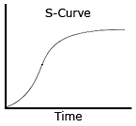Diffusion of innovations
Diffusion Theory
Diffusion theory is a model that explains how innovation is spread and adopted throughout a society. Adopters of innovation are categorized as innovators, early adopters, early majority, late majority and laggards. The Diffusion of Innovation model was developed by Everett M. Rogers, and uses an S-curve to graph the adoption of an innovation. Diffusion theory is used in many disciplines to explain trends, economic patterns, health and medical concerns and technology innovations. This model is an important part of change management and contains four key elements:
1. What is the innovation?
2. How is it communicated?
3. The idea is transmitted over time
4. The idea is diffused to members of the society
Adopters of innovation experience five stages of diffusion:
1. Knowledge - awareness of the idea and perceived benefit
2. Persuasion – convinced of the value of the innovation
3. Decision – judgment to adopt the innovation
4. Implementation – enacting the innovation
5. Confirmation - acceptance or rejection of the innovation
-- Jim Wright 13:41, 24 June 2007 (CDT)
The Innovation
New innovations follow a pattern of development. The steps include identifing a need or problem, researching and developing a solution, commercialization of the innovation, and spreading of the new idea. Once an innovation is adopted, certain consequences follow. These consequences are discussed at the bottom.
For any new idea to diffuse effectively there must be a relative advantage for using the new innovation. The innovation must be compatible with existing systems and can not be too complicated. It helps if a user can try the innovation themselves. Ultimately, there must be an improvement from the old way of doing something in order to expect the idea or technology to spread. 22:43, 2 July 2007 (CDT)
Communication Channels
Time
The Social System
Opinion Leaders are individuals who lead in influencing the opinions of others. Their behavior is important in determining the rate of adoption of an innovation in a system.
The Hypodermic Needle Model This model suggested that mass media had direct, immediate, and powerful effects on a mass audience. Examples included were the Spanish-American War, Joseph Goebbels, and Madison Avenue. The model was ultimately viewed as too simplistic, mechanistic, and too gross to accurately measure the effects of mass media. It also ignored the role of opinion leaders.
Consequences of Diffusion
Many innovations cause both negative and positive consequences. The adoption of new ideas within a social system can produce desirable or undesireable changes. Some changes have direct or indirect consequences. While others cause anticipated or unanticipated consequences. The main purpose of diffusion is to maintain dynamic equilibrium which is the ability to cope with the amount of change that is being diffused. 22:26, 2 July 2007 (CDT)
References
Rogers, E.(2003). Diffusion of Innovations, 5th Edition. New York: Free Press.
Brown, Lawrence A.(1981). Innovation Diffusion: A New Perspective.Methuen, NY.
